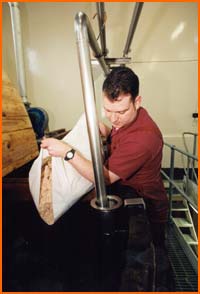 What is a Single Malt Scotch Whisky ?
What is a Single Malt Scotch Whisky ?
 What is a Blended/Pure Malt (Vatted) Scotch Whisky?
What is a Blended/Pure Malt (Vatted) Scotch Whisky?
The Scotch Whisky Manufacturing process
| |
In the production of Malt Scotch Whisky the basic raw materials are limited and consist of barley, water and yeast.
 The process comprises five distinct stages. The process comprises five distinct stages.
In two of the above stages the distiller is concerned with the behaviour of living organisms. In MALTING the involvement is the controlled germination of the barley corn and in FERMENTATION the action of the yeast when placed in a solution rich in fermentable sugars and growth factors. All living organisms are susceptible to conditions of their environment and many of the distiller's problems arise therefrom.
To read the full Manufacturing process (7000 words) please visitwww.scotchwhiskyresources.com
 It should be noted that there is no “right” or “wrong” way to drink Scotch whisky – it is very much down to a question of personal taste. However, let us offer a few basic suggestions and, for those interested in pursuing the pleasures of “nosing” and “tasting” further, we provide a link below to a detailed introduction to “nosing and tasting” scotch whisky. It should be noted that there is no “right” or “wrong” way to drink Scotch whisky – it is very much down to a question of personal taste. However, let us offer a few basic suggestions and, for those interested in pursuing the pleasures of “nosing” and “tasting” further, we provide a link below to a detailed introduction to “nosing and tasting” scotch whisky.
Many who drink Scotch whisky neat say they do not want to spoil the taste by adding water. However, equally as many will say that adding a touch of water, particularly if it is pure, soft spring water, (ideally the same spring water used in the making of the particular whisky!) serves to enhance the distinctive aroma and flavour of a whisky. Tap water may contain high amounts of chlorine and therefore would not complement any whisky - your best bet is to opt for bottled Scottish mineral water!
Adding ice to a whisky can provide a refreshing drink but it should be noted that it will dull the fine taste and wonderful aromas and so should never be contemplated when conducting a “whisky nosing and tasting.” Similarly, carbonated water is not an ideal accompaniment for whisky as it will also interfere with the aromas.
The addition of mixers such as ginger ale, soda and even coca cola, is a popular trend, however it does beg the question - why drink whisky at all if you need to mask the taste?
"Nosing” and “Tasting"
The sense of smell is one of the most sophisticated of all the senses, and the pleasure that can be gained from “nosing and tasting” the many wonderful and varied scotch whiskies available today is an experience that should be treasured. This is particularly true if it is experienced in a convivial atmosphere with a group of friends – old or new.
If you are interested in pursuing further recommendations regarding ;
|




No comments:
Post a Comment